The Friends of the Wildflower Garden, Inc.
Plants of the Eloise Butler Wildflower Garden
The oldest public wildflower garden in the United States
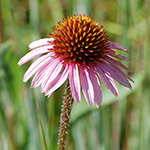
Common Name
Narrow-leaved Coneflower (Blacksamson Echinacea, Narrow-leaved Purple Coneflower)
Scientific Name
Echinacea angustifolia DC.
Plant Family
Aster (Asteraceae)
Garden Location
Historical - 1915 - not extant
Prime Season
Late Summer Flowering
Narrow-leaved Coneflower is a native perennial forb of the prairies. It grows to 30 inches high on erect unbranched stems, usually covered with spreading hairs. Stems are green to purplish.
The leaves are found on the base and lower parts of the stem and are usually in an ascending position. The basal leaves are 2 to 10 inches long, narrow, lanceolate to ovate in shape with 3 to 5 main nerves, margins are entire but usually with marginal hair. Leaf tips are roundly pointed, bases taper to a short winged stalk. Stem leaves are concentrated on the lower stem; they are alternate, 2 to 4 inches long at mid-stem and any above will be similar but smaller and the uppers will lack a stalk.
The floral array is usually a single flower head atop a long (6 to 10 inch) leafless hairy section of the upper stem, however the top may branch into 2 to 5 heads. The hair on stems and leaves and flower stalks is stiff.
The flowers have a hemispheric head composed of two types of florets: An outer band of ray florets that number 8 to 21, are neuter as to sex and have pink to purplish corollas and rays. The rays are 5 to 8 mm wide, short, slightly drooping, and are sparsely hairy on the back side. In the central hemisphere, which is 20 to 35 mm wide, there are up to 200 bisexual and fertile tubular disc florets whose corollas are yellowish while the five lobed tips are usually a darker purple. The lobes enclose the 5 stamens which tightly surround a single purple bifurcated style which is slightly exserted from the throat of the corolla. Like most Echinacea these disc florets become very prickly. The outside of the flower head is surrounded by a number of lanceolate shaped phyllaries, in several series, that are spreading and densely hairy.
Seed (Cypsela): Fertile disc florets produce a dry 4-angled smooth pyramidal shaped cypsela, 4 - 5 mm long, tan with the wider base a dark brown. These seeds are too large to be wind distributed very far from the parent plant so the plant does not spread far by seed. Seed germination requires 90 days of cold stratification. Best to put seed in the ground in the Fall and let Winter do the work.
Varieties: The literature sometimes lists two varieties, var. strigosa and var. angustifolia. Any differences between the two are not considered here and authorities such as Flora of North America (Ref.#W7) do not recognize the varieties.
Habitat: Narrow-leaved Coneflower grows from a fragile but very deep taproot, extending 4 to 6+ feet. It is not rhizomatous so the plant does not spread vegetatively. Propagation is best done by dividing the root crown when the plant is dormant or sowing seeds in late Fall. It grows best in dry well drained soils in full sun.
Names: The genus name, Echinacea, is from the Greek word echinos, a hedgehog, and alludes to the prickly central disc of these flowers. The species, angustifolia, means 'with narrow leaves'. The author name for the plant classification, from 1836, ‘DC’, refers to Augustin Pyramus de Candolle (1778-1841), Swiss botanist, who influenced Charles Darwin. He studied plants, began a systematic catalogue and has 2 genera named for him. The alternate common name of 'Blacksamson' is a reference to the woody root which has wedges of thick black woody parts.
Comparisons: The Pale Purple Coneflower, E. pallida, has narrower very long drooping rays, only 3 to 4 mm wide, that are paler in color - pink to reddish-purple; plus longer leaves, but the flower stalks and stems also have hair. The Eastern Purple Coneflower, Echinacea purpurea, has ray floret rays that are 6 to 10 mm wide, the central disc is more flattened on top, there is much less hair, the leaves are broader and have teeth and the roots are fibrous.
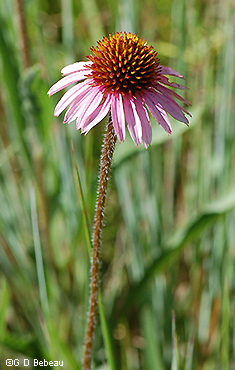

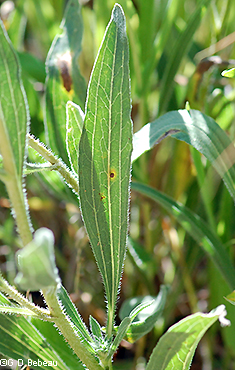
Above: 1st photo - The floral array is usually a solitary flower on a tall stalk. 2nd photo - Stems are unbranched with whitish spreading hair. Leaves are on the lower section. 3rd photo - Leaves are long and narrow, hairy, the lower leaves on winged stalks, the uppermost stalkless.
Below: 1st photo - Under the florets, are a number of lanceolate shaped phyllaries, in several series, forming the flower head. These are spreading and densely hairy. 2nd photo - Most of the stem is leafless, the leaves being basal or confined to the lower section.
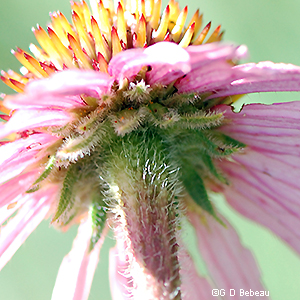
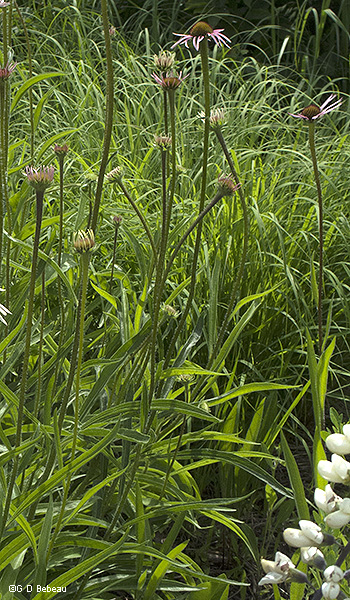
Below: The flower head is hemispherical with an outer band of 8 to 21 ray florets, usually sterile, and an inner dome of numerous fertile disc florets. These become very prickly with age.
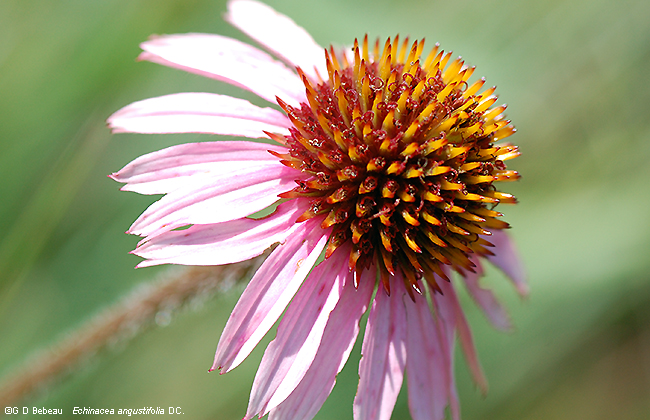
Notes: Eloise Butler introduced Echinacea angustifolia to the Garden on April 29, 1915 with 6 plants sourced from Horsford's Nursery in Charlotte VT. Later on August 5th she was thrilled to note it in bloom. On July 2, 1917 she planted what she termed "one poor root" from "Franklin", which I interpret as Franklin, Mass. where she obtained other plants from time to time. In April 1919 she planted 12 from Horsford's Nursery in Charlotte VT. More plants were added in 1927 and 1932. In her time and in Martha Crone's time when it was still listed as present in the Garden, the Narrow-leaved Purple Coneflower, was named by some as Brauneria angustifolia based on the name published by Heller in 1900 in Muhlenbergia, but that has been rejected with Brauneria no longer in existance and the species is now classified Echinacea angustifolia. Narrow-leaved Coneflower is native to the central plains states of North America, from Saskatchewan and Manitoba in Canada, south to New Mexico and Texas. In Minnesota it is found most counties of the western part of the state plus Ramsey and Dakota in the metro area. It is the only species of Echinacea native to Minnesota.
Medicinal uses: The coneflowers of the genus Echinacea have a medicinal history of people using the dried root of the plant to make a decoction in boiling water or a tincture in alcohol, both to treat impurities in the blood and a variety of infections. Native Americans used it to treat snakebite. When effective use of the plant in North America was reported to Europe, a number of remedies were made in Europe from the North American plants. Today it is still a big business as Echinacea can be found in herbal supplements, non-patent medicines, herbal teas to treat colds, etc., all marketed has preventatives, not cures. While E. angustifolia is the most frequently referenced species, all of the nine species native to North America are considered. Dr. Clapp (Ref. #2) recommended the use of this plant as far back as 1852, especially to induce the flow of saliva. Early travelers on the prairies called it "thirst plant" as chewing the roots, which had a salty, peppery taste, increased saliva flow thus relieving a dry mouth (ref #31). It was listed in the National Formulary from 1916 to 1950.
The decline in the wild population of E. angustifolia is partially related to habitat loss and partially to widespread digging of roots for medicinal purposes. Plants must be 3 to 4 years old before the root is large enough to be worthwhile harvesting. During the 1870s the Lloyd Brothers of Cincinnati Ohio marketed a bottle of "Volatile Oil of Echinacea Angustifolia" and Lewis and Clark noted the use of the plant several times in their Journals. The Smithsonian National Museum of Natural History has published a document on this. (PDF Format)
Return to -- Site Plan/Archive Index --or-- List of Common Plant Names -- or -- List of Scientific Names -- or --Home Page - - - Back to top.
References: Plant characteristics are generally from sources 1A, 32, W2, W3, W7 & W8 plus others as specifically applied. Distribution principally from W1, W2 and 28C. Planting history generally from 1, 4 & 4a. Other sources by specific reference. See Reference List for details.
 Identification booklet for most of the flowering forbs and small flowering shrubs of the Eloise Butler Wildflower Garden. Details Here.
Identification booklet for most of the flowering forbs and small flowering shrubs of the Eloise Butler Wildflower Garden. Details Here.
©2014
Friends of the Wildflower Garden, Inc. Text and photos are by G. D. Bebeau unless otherwise credited. "www.friendsofeloisebutler.org"
042220